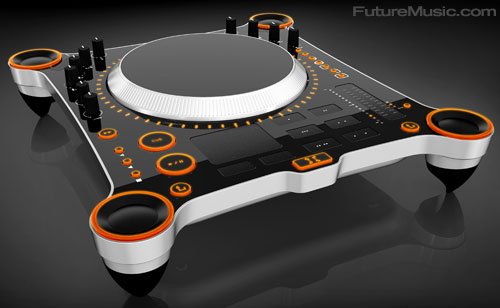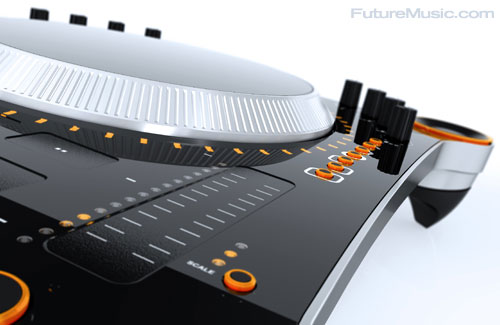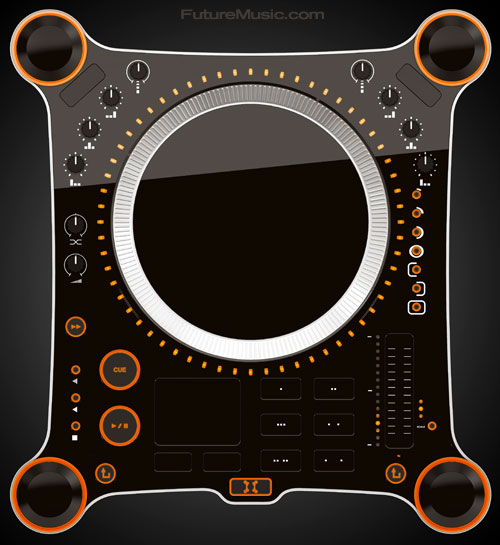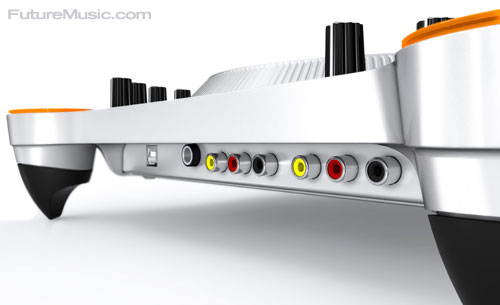
![]()
The new EKS OTUS DJ MIDI Controller
Ramsay has since retired and sold his interest to a silent group of investors who are now financing the company's new OTUS line of DJ hardware. However, his dream of creating "future-proof" DJ controllers, that are on the cutting-edge, still fuels the reinvigorated company.
We discussed EKS and the new OTUS with Sulevi Seppänen, Sales Director, to find out more about this innovative controller and the company that's driving its development. EKS is very focused on its "future-proof" brand message and applying the company's forward-thinking philosophy to not only hardware and software, but to dance music's evolution as an art form.
To ensure that all of their products are future-proof, EKS is committed to separating the software from the hardware, and keeping current and future products "open." With their MIDI mapping middle-ware, they are making it easy to use the OTUS with any software, and not anchoring the controller to any one software mixing solution. This allows the controller to remain relevant even as the software naturally evolves year after year.

![]()
The futuristic design of the OTUS created a sensation at this year's trade shows
This new approach is certainly an about-face from years ago, when the company was championing their own Bison mixing software. Although, Bison was one of the early entrants into the digital mixing market, it never caught on due to its lackluster graphical user interface (GUI), and very limited feature-set. Even though Bison was Dead On Arrival, the company still wasted a good deal of resources promoting and developing the software instead of forging relationships with the leading solutions. Seppänen has confirmed that although EKS is still offering Bison, its development is now on the "back burner."
As part of the rebranding effort, EKS has recently redesigned their website to reflect their future-proof philosophy, and present the heritege of the company, which they assert was started in 1955, and called Voimaradio Oy. This is somewhat of a misstep, since the "old EKS" has nothing to do with the new EKS, and Voimaradio Oy certainly doesn't carry much brand currency with the new generation of EKS customers, who care much more about their new products than Tapio Matti Köykkä, a reportedly "controversal figure" in the Finnish audio community.
To further assert their agenda, EKS has developed what they call "The EKS Digital Manifest." Here's some highlights:
While some may feel that this declaration is grandstanding, its goal is to demonstrate the company's commitment to developing cutting-edge products.

![]()
The OTUS mixes traditional DJing controls with new concepts
Like the XP-10 before it, the OTUS has a 24bit, four channel, built-in sound card with a claimed frequency response of 4Hz-24kHz and a Signal To Noise Ratio of >115dB. Two Burr-Brown I2S handle Digital Audio Conversion. The multichannel sound out allows the OTUS to be utilized as two decks, as well as adds some other dynamic audio routing capabilities, a competitive advantage over other controllers.
Besides the integrated sound card, the OTUS features motion controllers. "We wanted to give the DJ the ability to incorporate more show factor into their sets," Seppänen reveals. "It was important to us to provide the DJ with a more artistic and visual approach to mixing." The motion controllers, which work on the vertical axis, can be MIDI assigned to filters, resonance, delay feedback and any other creative attribute.
Seppänen is careful to point out that the OTUS is not an "all-in-one controller," meaning is not meant to be a one-size-fits-all product for all types of DJs in every genre, though it can be used with practically any mixing program. "The emphasis [for the OTUS] is on effects, and for live remixing, as well as mashups," Seppänen discloses. In fact, Seppänen goes on to reveal that future EKS controllers will be targeted to different styles of DJing and genres.

![]()
The rear view of the OTUS reveals the USB connectivity and built-in sound card
To determine what's next, EKS is constantly asking themselves: What new ways are there to manipulate music? Is there new way of playing songs? What new plug-ins will be used? And, what type of controls will a DJ use beyond the turntable paradigm?
Although, EKS plays nice with the latest leading mixing software, the company is very open to working with emerging startups who are pushing the software envelope. In fact, Seppänen revealed that the controller should be designed for the software and not the other way around. "The software should dictate the development of the hardware and not be tied to the turntable model." That said, Seppänen still feels that the controller's architecture should remain as open as possible to inspire DJs to figure out new ways and methods of mixing that others never thought possible.
Despite the fluctuations in currency, Seppänen still hopes to bring the OTUS to the US market for under $1000 - prior reports put the controller in the $700 to $800 range. This positions the controller between the Vestax VCI-100, and some of the new models announced by Stanton and Numark at NAMM and MusikMesse. With a built-in soundcard, advanced MIDI controls, and a futuristic design, the EKS could find a substantial niche in the market - now that the DJ community is finally ready to embrace Antero Ramsay's original Briefcase DJ Rig.









1 komentar:
Beautiful, If it works as good as it looks, then i gotta get a couple!!